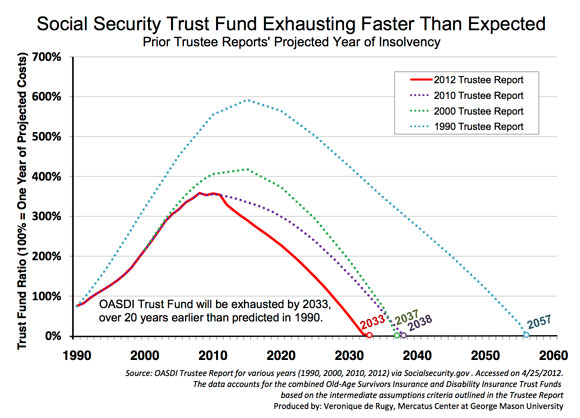- | Government Spending Government Spending
- | Data Visualizations Data Visualizations
- |
Social Security Trust Fund Exhausting Faster Than Expected
According to the latest Social Security Trustee Report released last week, the Social Security trust fund will likely be exhausted by 2033—that’s 3 years earlier than last year’s projection and more than 20 years earlier than projections made in 1990.
According to the latest Social Security Trustee Report released last week, the Social Security trust fund will likely be exhausted by 2033—that’s 3 years earlier than last year’s projection and more than 20 years earlier than projections made in 1990.
Mercatus Center senior research fellow Veronique de Rugy compares projected Social Security trust fund exhaustion dates from Trustee Reports that date back to 1990. The trend is clear: The Old-Age, Survivors, and Disability Insurance (OASDI) trust fund is being exhausted much faster than predicted.
The pattern of earlier exhaustion dates has been a function of various factors including demographics (e.g., population, life expectancy), economic prospects (e.g., cost of living, average wages), and program-specific assumptions (e.g., beneficiaries’ current-payment status). But the real problem is that, for years, the federal government has used Social Security’s surpluses to pay for roads, education, and wars. Now that the Social Security program will be demanding its money back from the Department of Treasury on an annual basis, the government will have to borrow more and more from investors, increasing the publicly held debt at a greater pace.
Social Security benefits hinge on what’s available in the trust funds. Without a positive balance in the trust fund, the program won’t be able to pay full benefits but only what it collects in taxes, which would require an across-the-board cut in benefits. By 2033, benefits would have to be slashed by 25 percent.
The silver lining to Social Security’s new annual deficit is that it exposes the fiction that the program doesn’t need reform because it is fully backed by tax contributions. Lawmakers have many policy options to choose from: private accounts, privatization with safety nets for the poor, or eligibility age hikes. The only bad option is to do nothing, which would mean cuts in benefits and more additions to U.S. debt.
*Note on data: The year of exhaustion is the first year a trust fund is projected to run out of funds and be unable to pay benefits on time and in full. The trust fund ratio is the amount in the trust fund (assets) at the beginning of a year divided by the outgoing amounts (annual expenditures) for the year. It shows what percentage of the year’s expenditures the trust fund has on hand. For example, a trust fund ratio of 100 percent would reflect an amount equal to 1 year of projected expenditures.


